The story of a prescribed burn
Enlarge
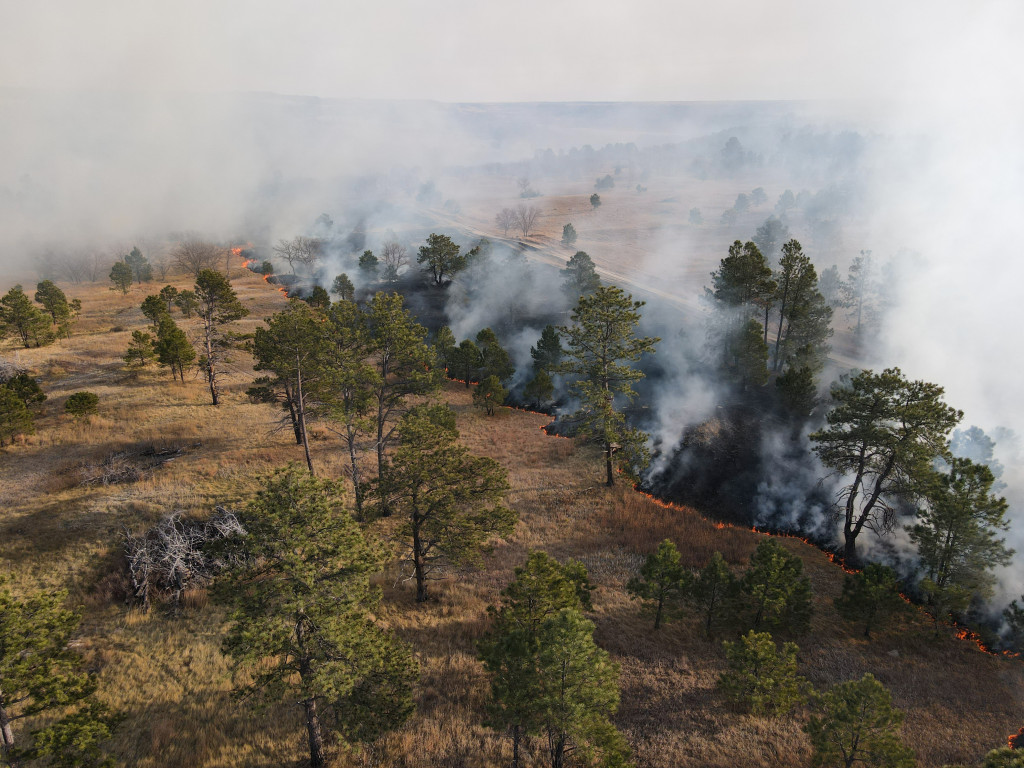
Photo by Chad Bladow
By Gerry Steinauer, Botanist
My introduction to the central Niobrara River Valley came in 1984 when, fresh out of college, I interned on The Nature Conservancy’s Niobrara Valley Preserve located east of Valentine. My job on the recently-acquired preserve was to design and build nature trails, help move cattle between pastures on horseback, and fix windmills and fences, along with other miscellaneous ranch duties.
On evenings and weekends, I explored. For a kid from the outskirts of Omaha that didn’t travel much while growing up, the 56,000-acre preserve was terra incognito. I hiked rocky canyon rims, deep-shaded woods and prairie-covered dunes, and swam and fished in the cool, sandy waters of the Niobrara. This young botanist was also enthralled by the valley’s rich flora: More than 600 plant species are found on the preserve alone. By summer’s end, the preserve had its hooks in me.
Throughout my 32-year career with the Nebraska Game and Parks Commission, I have taken every opportunity to return to the preserve, whether it be to conduct plants surveys, help with workshops or assist with prescribed burns. Case in point: In December 2021, I received an email stating that a prescribed burn was planned for the next day, and help was needed. That evening, I packed my fire gear, and the next morning, I was on the road early for the long drive north. This is the story of that burn.
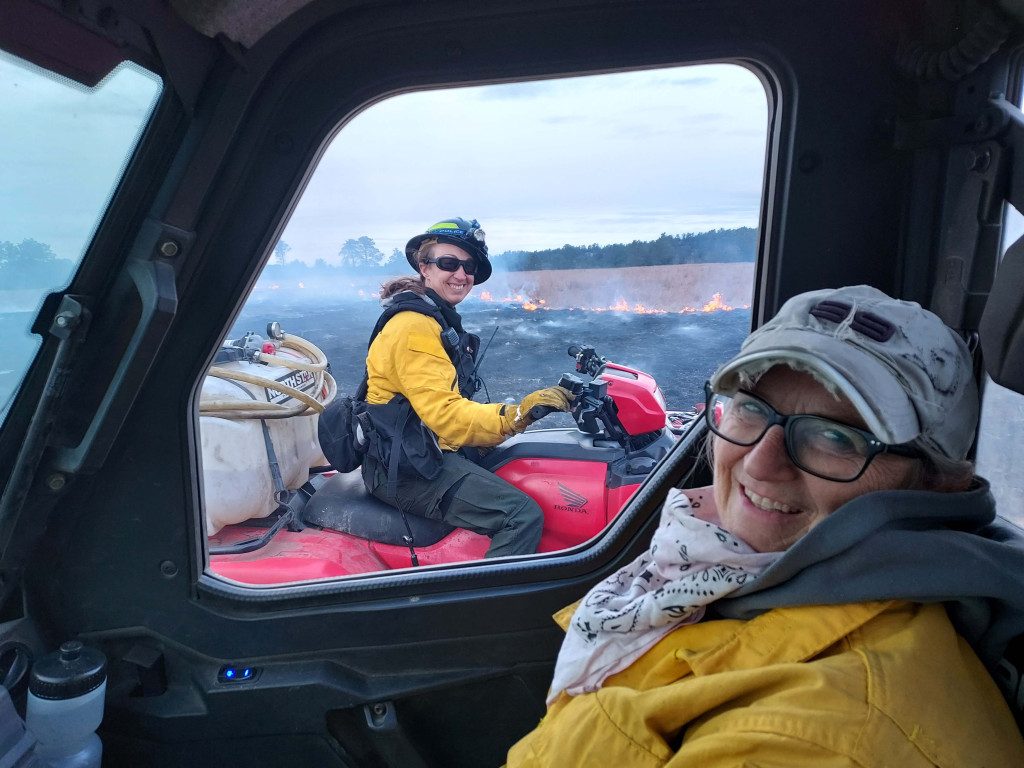
Photo by Gerry Steinauer.
The Bluff Ecosystem
The burn unit was the bluff on the south bank of the Niobrara River between Brewer Bridge and Smith Falls State Park. Thousands of canoers, kayakers and tubers float past these bluffs each year as they occur within a popular 76-mile stretch of the Niobrara designated as a National Scenic River. Here, the bluff rises sharply from the river. Its moist, low slopes are cloaked with deciduous woodlands of bur oak and a lesser abundance of hackberry, basswood and ironwood. Deep side canyons cut by spring-fed streams dissect the bluff and harbor rare, glacial-relic stands of paper birch and aspen trees. And ponderosa pine woodlands and Sandhills dune prairie are interspersed on the dry, sandy upper bluffs, the latter extending southward to the horizon.
As has happened throughout Nebraska, Euroamerican settlement has affected the native Niobrara landscape. One consequence of settlement, fire suppression has allowed eastern red-cedar, ponderosa pine and other woody plants to proliferate to unnaturally high levels. Studies of fire scars in the growth rings of live old trees and the stumps of long-dead trees dating back to the late 1600s show that, prior to settlement, wildfires occurred in the valley on average every five to 15 years. Frequent fire maintained treeless prairies; open, vigorous woodlands; and savannas, prairie with scattered trees. In addition, the wide-burning fires periodically consumed downed wood, fallen conifer needles and other fuels, keeping fire intensity low to moderate.
Not allowing fires to burn regularly has led to an over-accumulation of fuels. Now, when wildfires do start, they can burn hot, as happened during the drought-stricken summer 2012, when lightning strikes set the Niobrara valley ablaze, charring more than 76,000 acres and destroying miles of livestock fence and several homes.
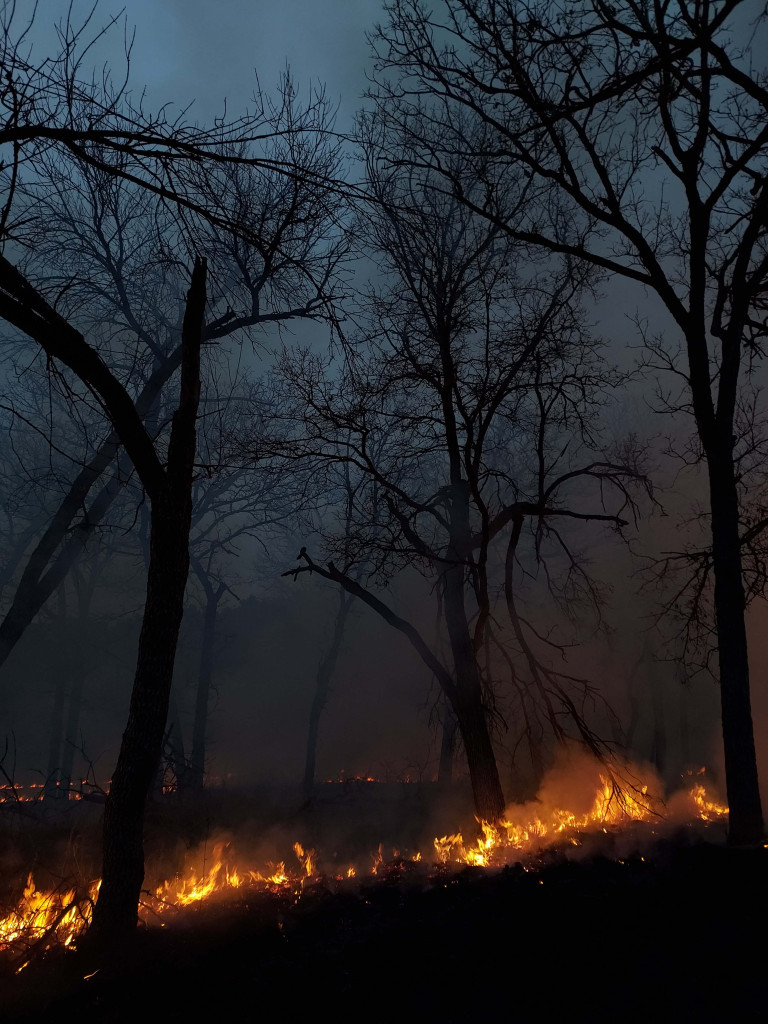
Beginning in the early 2000s, the conservancy hired contractors to cut and pile cedars and smaller pines on the bluffs near Brewer Bridge and elsewhere to combat the abundance of trees and fuel. In March 2014, they conducted a prescribed fire on these bluffs; the aim was to consume the dry tree piles and ground litter and kill uncut young cedars and pines. Unfortunately, I had other obligations that day and missed the burn.
In the years following that burn, the conservancy cut additional cedars and pines from the bluffs, but the conifers would not go down without a fight. New seedlings sprouted and quickly grew to saplings and, if left unchecked, cedars and pines would again choke the bluffs in a matter of decades. Now, while trees were young and most vulnerable to heat and flame, was the time to hit them again with fire.
The Fire
Late in fall 2021, the central Niobrara valley was prime for prescribed burning. There was no snow on the ground, and it was unseasonably warm.
On the morning of Dec. 9, I was among the 15-person burn crew that gathered in the parking lot near Brewer Bridge. The early arrivals milled about in small groups sipping coffee, talking and joking, while the latecomers organized their gear and donned their bright yellow and dull green, fire-resistant Nomex clothing. Represented were staff of The Nature Conservancy, Game and Parks, Northern Prairies Land Trust and Turner Enterprises, Inc., as well as several volunteers. They were a tight-knit group, most having burned together in the past. When all were ready, Chad Bladow, the conservancy’s prescribed fire coordinator and burn boss for this fire, huddled the crew together for a briefing, and the mood turned serious.
Maps of the burn unit were passed out, and Bladow reviewed the ignition pattern, possible danger areas and the day’s weather. He then assigned each member to one of four teams and assigned line bosses, his trusted field lieutenants, to lead each team. Three teams would light the fire using drip torches, fuel-filled metal canisters with long spouts from which fuel drips across a burning wick and onto the ground. The fourth team would patrol the fire breaks in all-terrain vehicles and pickups equipped with water tanks and pumps. Their critical job was to prevent flames from creeping across or jumping the break. Radios were passed out to provide vital communications as the teams spread out and the burn progressed.
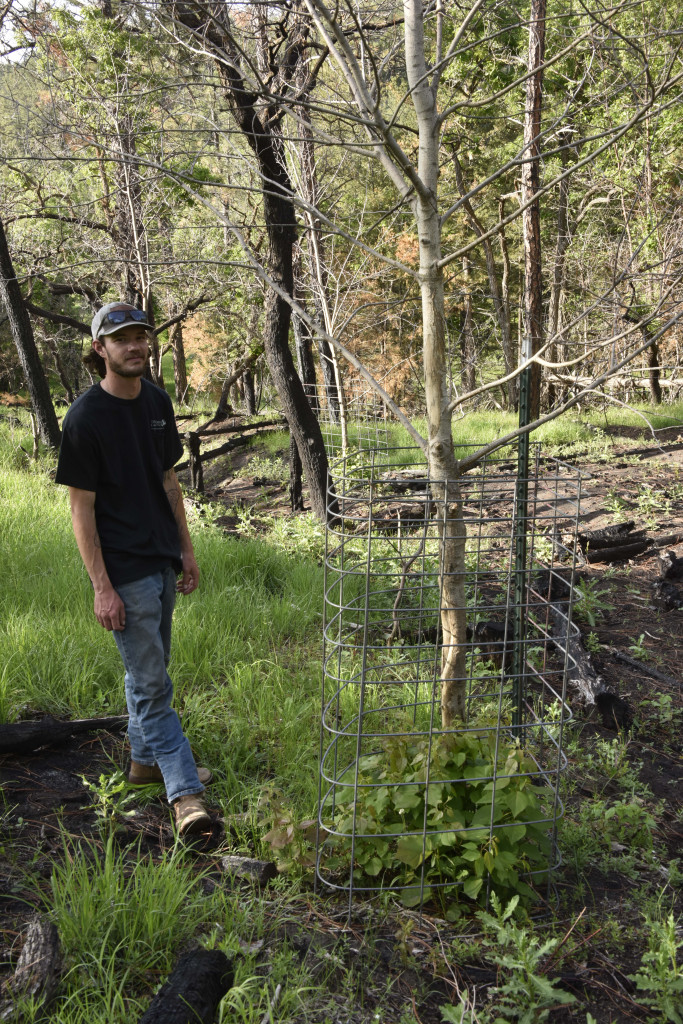
With the meeting over, the crew crossed the bridge in a caravan of vehicles and lumbered up the two-track trail to the prairie flat above the bluff. With the wind out of the north, the burn would start here on the downwind side of the unit’s east end, with the trail road, which ran the length of the two-mile-long unit serving as the south fire break.
With Bladow orchestrating from the front seat of his four-wheel-drive pickup, one crew started lighting the backfire directly off the trail. The fire burned slowly into the wind, creating a blackened fire break. Another crew followed the first, filling in unburned gaps and widening the blackened area. Lighting the backfire along the south line took several hours and was mostly uneventful. Only once did tension fill the air.

About noon, as the fire burned through a ponderosa pine stand near the trail road, the resin-soaked bark of several trees caught fire. The crackling flames quickly climbed their trunks, sending embers skyward. These trees needed to be quickly extinguished or the wind might carry embers over the trail road and outside the burn perimeter. The call for help went out over the radio, and the dirty work began. First, crew members pushed through the heat and smoke of the flaming trees and doused them with streams of water. With the flames extinguished, they used heavy rakes to break still-smoldering bark from trunks and limbs to prevent the trees from reigniting.
Despite the crew’s rapid response, a few embers landed across the trail road, igniting small fires in dry grass beyond. Before these “spot fires” could grow and intensify, waiting crew members snuffed them out.
Spot fires are an expected part of prescribed burns, especially those including hot-burning, ember-producing cedars, pines, brush piles or tall grass, and on days when low humidity allows the errant embers to easily ignite dry grass or dead wood. Skillfully, our crew, like all trained fire crews, predicted and was prepared for the spot fires.
With the flaming pines extinguished, the crews lighting the backfire continued to work westward. One could now gaze eastward and see a towering smoke plume rising near the river. The south line secured with a wide, fire-blackened buffer, the third crew had started lighting the headfire at the base of the bluff in the unit’s northeast corner. Pushed by the wind and burning upslope, the fire sent a wave of heat ahead, pre-heating and drying the fuels, intensifying the flames and sending many smaller cedars and pines to the afterlife.
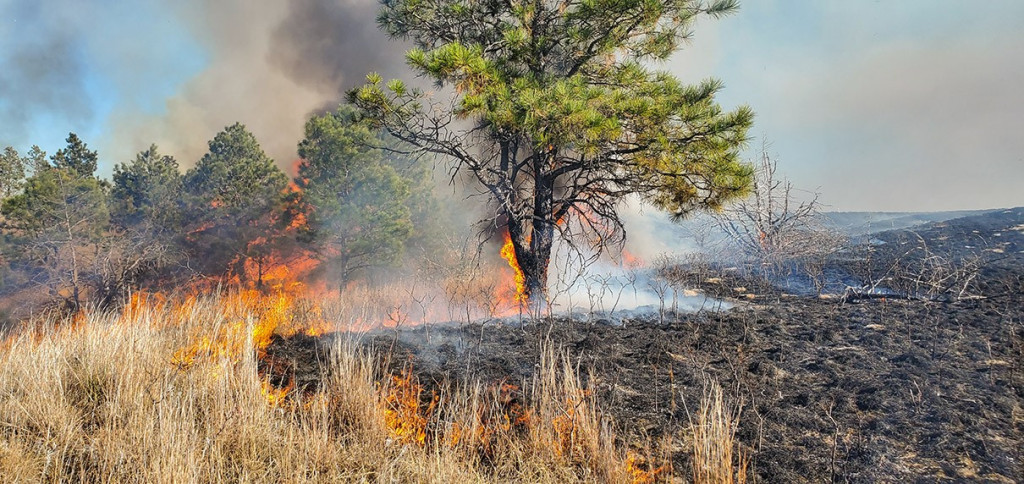
At this point, I was on the ridgetop, tasked with the duty of protecting a plastic deer blind set on short wooden poles by lighting a fire around its perimeter, a practice known as blacklining. The grass around the blind had been mowed, but blacklining would add protection. As I drove a utility vehicle into the unit from the southwest, thick smoke began to block my path as I neared the blind. When I peered down the ridge, I saw flames heading my way: The crew lighting the fire along the river had advanced farther than expected. I reversed course, leaving the blind to fate.
By late afternoon, the crew lighting the backfire had reached the unit’s west boundary. They then turned north and lit along a mowed break that snaked down a gentle slope of the bluff, tying the fire off to the river. Soon, the crew setting the headfire would also reach this point, encircling the unit with fire. Behind them, the backfire and headfire were merging high on the bluff, like the sides of a slowly closing zipper, and extinguishing themselves.
In the dimming light of sunset, crew members set fire in the last unburned patches of oak timber low on the bluff that the headfire had passed by. Slowed by the evening chill, their flames crept across the forest floor, casting a pale, eerie glow onto the sprawling branches above. When the last of these fires petered out, darkness enveloped the bluff. The burn was complete. The crew dispersed for a good night’s sleep, except for a lone sentinel who stayed late into the night to patrol the burn perimeter.
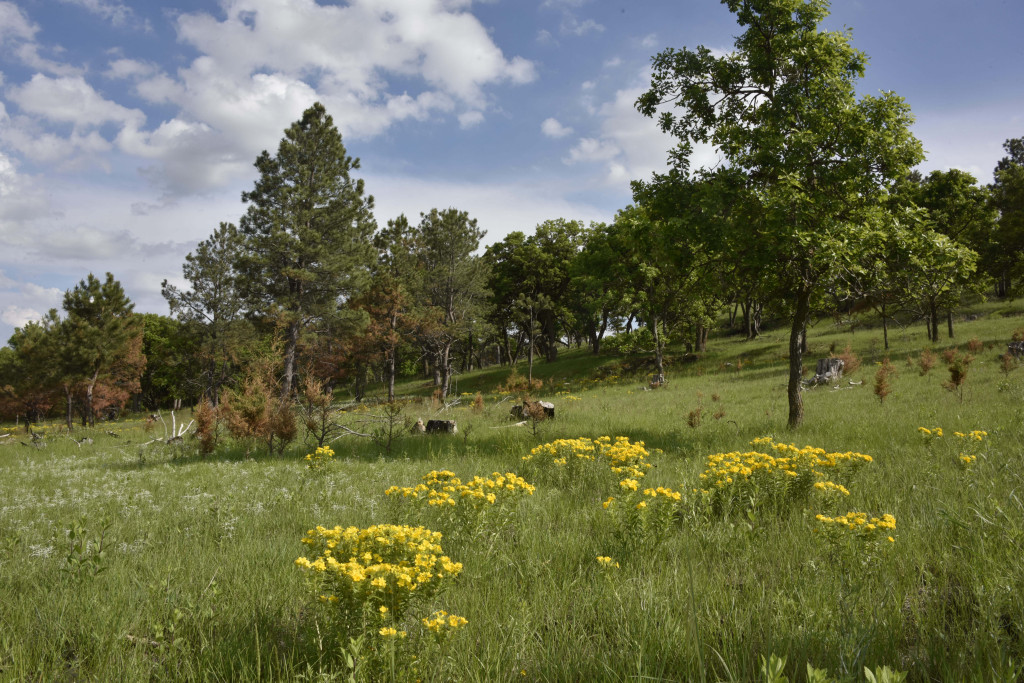
Post-fire
Last June, I hiked the bluff with Bladow and Carson Schultz, assistant manager at the preserve, to view the results of the fire. To our delight, many young cedars and pines had died in the burn. Many of the dead still clung to their slow-cooked foliage, now brownish-orange, but where the fires burned hot, these saplings were skeletons of charred stems and limbs. In the oak woodlands, the fire had top-killed many smaller, shade-producing ironwoods and hackberries. Although these trees would eventually re-sprout, more sunlight was now reaching the forest floor, allowing wildflowers to flourish. Only a few aspen saplings had been top-killed, but these, too, would re-sprout.
And the deer blind? The short, mowed grass below the blind, somewhat miraculously, never caught fire and the blind survived.
At day’s end, we sat on a high hill and gazed down on a bluff that hardly resembled its pre-restoration state: The tree cutting and fires had done their job. Low on the bluff, the oak woods were now open, and the high slopes were cloaked with oak and ponderosa pine savanna. The fuel level was visibly reduced, making the bluff ecosystem more resistant to future wildfires. This one-time intern glowed with satisfaction. ■
Trained by Fire
Chad Bladow was raised in the small town of Hankinson, North Dakota. He spent his childhood summers on his grandparents’ nearby farm and lake-side cabin where he roamed the land, camped, fished and developed a love of nature.
In 1996, while pursuing a degree in wildlife and fisheries from the University of North Dakota, his venture into prescribed fire began when he interned for a semester in Florida and helped burn pine woodlands. After college, Bladow was hired by The Nature Conservancy to manage preserves in southern Indiana, including helping with prescribed burns, mainly in oak woodlands. By 2002, he had acquired enough training and experience to become a conservancy burn boss, allowing him to lead prescribed fires on their lands. By 2010, Bladow had met the rigorous standards required to become a federally certified burn boss, the pinnacle of the position. This level of fire leadership requires extensive knowledge of fire behavior in a wide range of plant community types, topography and weather; leadership and planning skills; and the ability to maintain one’s cool under pressure.
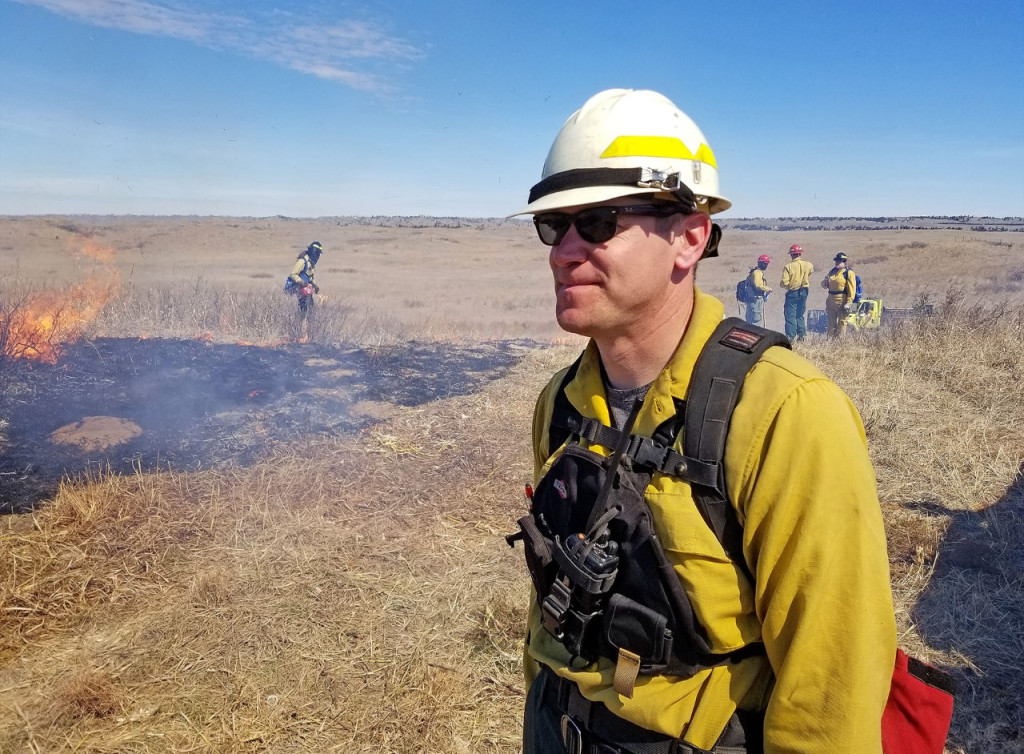
Bladow began traveling from Indiana to the Niobrara Valley Preserve to lead burns, and in 2018, he accepted the position of prescribed fire coordinator stationed at the preserve. His duties now included planning and leading prescribed burns on conservancy preserves throughout the state and helping other conservation groups and private landowners in the northern Sandhills and Niobrara River valley plan and conduct prescribed burns.
“Chad has been great helping us implement prescribed fire in north-central Nebraska,” said Scott Wessel, a Commission wildlife biologist stationed in Norfolk. Most ranchers and other landowners throughout the state have little or no experience using prescribed fire and need leadership and guidance to get fire on the ground, Wessel said. “Chad has a knack for understanding a landowner’s comfort level with fire, and if they are uncomfortable, helping them work through their concerns. He has that rare balance of confidence and humility needed for his job,” he said.
To date, Bladow has helped conduct prescribed burns on 15,000 acres of prairie and woodland in north-central Nebraska.
The post Flames on the Niobrara appeared first on Nebraskaland Magazine.
















